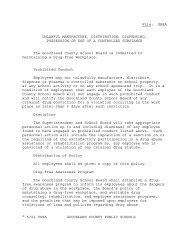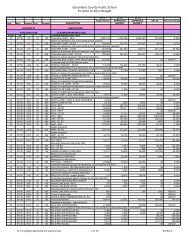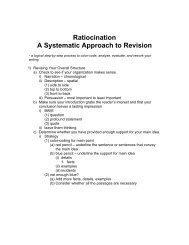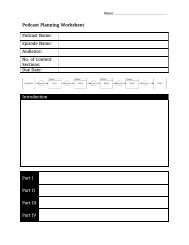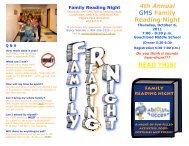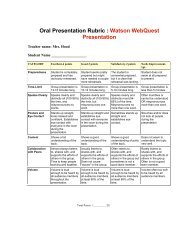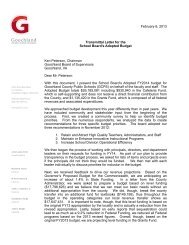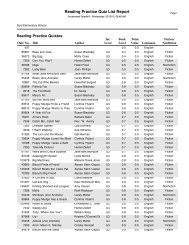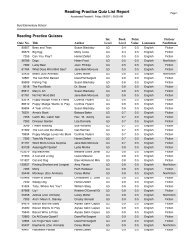Balanced Assessment Project - Goochland County Public Schools
Balanced Assessment Project - Goochland County Public Schools
Balanced Assessment Project - Goochland County Public Schools
Create successful ePaper yourself
Turn your PDF publications into a flip-book with our unique Google optimized e-Paper software.
BALANCED<br />
assessment<br />
PROJECT<br />
<strong>Goochland</strong> <strong>County</strong> <strong>Public</strong> <strong>Schools</strong><br />
MAY 2013
Why <strong>Assessment</strong> is Important<br />
What It Means to Assess<br />
Learning is a continuous process that starts before<br />
children come to school and continues after they<br />
graduate.<br />
<strong>Assessment</strong>s are tools we use to see what a student<br />
knows, so that we can plan the next learning<br />
experience in addition to reporting what progress has<br />
been made in school. <strong>Assessment</strong>s come in a variety of<br />
forms: from classroom tests and quizzes to college<br />
entrance exams. They can also include informal<br />
questioning prior to or following instruction. Some<br />
assessments turn into a grade for a student, but many<br />
more are designed to course-correct instruction.<br />
When we prepare for strong instruction, educators<br />
want to know what students already know before new<br />
learning begins. This is one of the primary purposes of<br />
assessment: to establish a baseline of knowledge.<br />
Three Major <strong>Assessment</strong> Types<br />
Achievement Aptitude Growth<br />
Traditionally, schools focus the majority of their time<br />
and energy on achievement tests. Virginia’s SOL<br />
(Standards of Learning) tests are a measure of<br />
achievement; in this case, a prescribed minimum<br />
proficiency based on common grade level and course<br />
standards. Generally, classroom tests and quizzes and<br />
division marking period assessments are achievement<br />
measures. These tests can be formative or summative in nature.<br />
<strong>Schools</strong> typically dedicate a small portion of time and<br />
resources to aptitude testing. These tests are designed to<br />
predict future success, rather than measuring a student’s<br />
understanding about a body of knowledge. The SAT is an<br />
example of an aptitude test, predicting college success.<br />
Finally, there are growth assessments. These kinds of tests are<br />
designed to measure individual student progress and can show<br />
learning trends over time. (It may be helpful to think about the<br />
growth chart (for height) in a pediatrician’s office.) What growth<br />
assessments provide that other tests do not is a studentspecific<br />
measure of progress between points in time. Growth<br />
assessments compare a student’s current performance to his<br />
own prior performance, while providing teachers and parents<br />
with a clear picture of the value added by instruction, practice,<br />
and the overall school experience.<br />
<strong>Balanced</strong> <strong>Assessment</strong> <strong>Project</strong> page 2
What is <strong>Balanced</strong> <strong>Assessment</strong>?<br />
The Importance of <strong>Assessment</strong><br />
Teachers want to maximize instructional time. Long stretches of sustained test administration steal a significant amount of<br />
that valued time for teaching and learning each school year. This is why we are reconsidering. It’s why we have developed the<br />
<strong>Balanced</strong> <strong>Assessment</strong> <strong>Project</strong>.<br />
Our goals are to (1) reduce significantly the amount of traditional benchmark testing (achievement), to (2) adopt<br />
more efficient assessments that measure individual student growth in the areas of literacy and mathematics,<br />
to (3) introduce performance assessments that measure depth of knowledge and application, and to (4)<br />
provide our teachers and students with a net gain in instructional time. Back to the medical analogy: We can<br />
think of educational testing like a visit to the doctor. The right assessment profile and the resulting data<br />
(diagnosis) will help ensure achievement and individual academic progress (health) for all learners.<br />
Balancing <strong>Assessment</strong> for a Better Picture of Progress<br />
Achievement measures alone will always provide an incomplete picture of student learning. We support common standards<br />
and their associated measures of student achievement, but recognize the shortsighted view of learning they provide if taken<br />
to represent the complete profile of a student’s learning. A thoughtful balance of growth measures and achievement<br />
measures provides a more complete view.<br />
What is the real benefit of using both kinds of assessment? We believe that standards and the corresponding state<br />
assessments are an important part of achievement and accountability. However, on their own they provide an incomplete<br />
picture of student learning. The addition of progress measures aimed at capturing student growth will allow us, for the first<br />
time, to focus on maximizing the individual potential of every child.<br />
Expanding on 21 st Century Skills<br />
<strong>Goochland</strong> has been working on the development of so-called twenty-first century skills with<br />
students through its G21 framework. But what does a twenty-first century assessment look like?<br />
Our <strong>Balanced</strong> <strong>Assessment</strong> <strong>Project</strong> has to look beyond traditional achievement tests to performancebased<br />
assessments. Beginning in Summer 2013, we will be developing classroom assessments that give students<br />
tasks where the application of knowledge is measured, using important skills such as communication, creativity, problemsolving,<br />
and collaboration. We believe this type of assessment has great potential—it will mimic real life situations just as our<br />
G21 projects have encouraged the creation of products using real world technologies.<br />
<strong>Balanced</strong> <strong>Assessment</strong> <strong>Project</strong> page 3
<strong>Assessment</strong>s at a Glance<br />
Test PREK K 1 2 3 4 5 6 7 8 9 10 11 12 type timeframe purpose<br />
Developmental Spelling Analysis • • • • • diagnostic fall, winter, spring<br />
to inform spelling (word work) instruction<br />
Division Writing Prompt • • • • • • achievement fall, winter, spring to measure writing development<br />
Elementary & Middle<br />
Division Benchmark Tests<br />
• • • • • • • • • achievement winter, spring<br />
Explorer • aptitude spring college readiness<br />
High School Benchmark Tests • • • • achievement fall, winter, spring<br />
Measures of Academic Progress (MAP) • • • • • • • • • growth fall, winter, spring<br />
Naglieri Non-Verbal Ability Test • aptitude spring<br />
Otis-Lennon School Ability Test (OLSAT) • • • aptitude spring (winter)<br />
Performance <strong>Assessment</strong>s • • • • • • • • • • • • • performance winter<br />
Phonological Awareness Literacy Screening<br />
(PALS)<br />
• • • • • diagnostic fall, (winter), spring<br />
PLAN • aptitude spring college readiness<br />
Preliminary Scholastic <strong>Assessment</strong> Test (PSAT) • aptitude spring college readiness<br />
Scholastic <strong>Assessment</strong> Test (SAT) aptitude fall, spring college readiness<br />
Standards of Learning (SOL) Tests • • • • • • • • • • achievement spring (end of course)<br />
Stanford 10 • aptitude winter<br />
W!SE Financial Literacy Test • • achievement spring<br />
reduction of over 80% of MP tests from<br />
SY 2012-13<br />
reduction of ~50% of MP tests from SY<br />
2012-13<br />
to measure academic progress in literacy<br />
and math<br />
universal screening for gifted consideration<br />
for all students<br />
universal screening for gifted consideration<br />
for all students; 8th grade for<br />
Governor’s <strong>Schools</strong> applications<br />
in development; to measure application<br />
of content and skills<br />
to inform early literacy instruction; given<br />
in the winter for Title I<br />
to measure achievement against Virginia<br />
standards<br />
for admittance to Governors <strong>Schools</strong>;<br />
given in 8th grade<br />
to measure state personal finance literacy<br />
standards<br />
<strong>Assessment</strong>s have the potential to do so much more than prepare for high stakes, required testing at the end of the<br />
year. A balanced approach can inform instructional decisions, help to foster creativity, diagnose learning styles,<br />
measure achievement, provide a platform for application of skills, and measure growth.<br />
<strong>Balanced</strong> <strong>Assessment</strong> <strong>Project</strong> page 4
Comparing Our Strategy<br />
Classic Classroom <strong>Assessment</strong>s (SY 2012-13) <strong>Balanced</strong> <strong>Assessment</strong> Approach (SY 2013-14)<br />
During the 2013-14 school year, <strong>Goochland</strong> will begin<br />
adopting the use of common formative assessments in<br />
lieu of benchmark tests at the high school and in some<br />
middle school courses. Progress or growth measures<br />
will be added, while the overall number of assessments<br />
given to all children will decline.<br />
Proposed Changes (SY 2013-14)<br />
Marking period 2 (MP2) would be an opportune time to<br />
introduce performance-based assessments that give<br />
students the opportunity to apply both skills and<br />
knowledge towards the completion of a task. These will<br />
be in development beginning in Summer 2013 in limited<br />
numbers.<br />
Both benchmark tests and common formative<br />
achievement tests would be delivered using an online<br />
system to add to each student’s growing data profile.<br />
benchmark achievement growth measure common formative achievement performance task<br />
<strong>Balanced</strong> <strong>Assessment</strong> <strong>Project</strong> page 5
Spring 2013 Committee on Growth Measures<br />
<strong>Goochland</strong>’s Committee Formed<br />
We established our Committee on Growth Measures, comprised of representatives from all five schools to address the issue of<br />
creating more balanced assessments. The team’s charge was twofold:<br />
(1) identify and recommend the best growth measure for <strong>Goochland</strong> <strong>County</strong> <strong>Public</strong><br />
<strong>Schools</strong>,<br />
(2) consider a PK-12 assessment profile that balances achievement and growth,<br />
Process<br />
one that more completely captures student learning.<br />
Our nine-person team met throughout the spring semester, during which time we<br />
explored the following state-approved (March 2013) vendors: Curriculum Associates,<br />
Global Scholars, Interactive Achievement, Northwest Evaluation Association (NWEA),<br />
Renaissance Learning, and Scholastic, Inc. Pairs of committee members researched<br />
each assessment, identified pros and cons, and summarized findings. Finally, the team<br />
Committee Membership<br />
Stephen Geyer, CO<br />
Alison Gooding, GES<br />
Preston Gordon, GHS<br />
John Hendron, CO Technology<br />
Michael Jarvis, GMS<br />
Tina McCay, GES Principal<br />
Bridget Parker, GHS SPED<br />
Jamie-Ellen Spessard, RES<br />
Christina ompson, BES<br />
participated in on-site vendor presentations and demonstrations before reaching consensus on recommendations.<br />
Committee Recommendations<br />
(1) Adopt NWEA’s Measures of Academic Progress (MAP)<br />
as our growth measure to begin implementation in<br />
Fall 2013: K-8 literacy and math; 9-12 special<br />
populations; fall/winter/spring administration,<br />
(2) Replace Schoolnet with Interactive Achievement as<br />
our tool for common assessments, limit division<br />
benchmark testing, and SOL test simulation,<br />
(3) Discontinue the following formal assessments:<br />
(a) Grades K-8 MP1 benchmark testing,<br />
(b) Grades K-8 MP2 benchmark testing,<br />
(c) Grades K-8 math and English MP3<br />
benchmark testing,<br />
(d) Grades K-1 MP4 benchmark testing,<br />
(e) Grade 2 math and English MP4 benchmark<br />
testing,<br />
(f) QRI testing,<br />
(g) formal math pretesting, and<br />
(h) PALS non-mandated screening.<br />
Benefits<br />
Virginia’s SOL tests measure a prescribed standard at a fixed point in<br />
time: < 400 is considered failing; 400-600 is considered passing. Does<br />
this mean that every 395 is a failure and every 600 is a success? What<br />
if the student who scored a 395 on the spring SOL test also<br />
progressed three reading levels during the school year? What if the<br />
student who scored a 600 also scored a 600 on the practice test nine<br />
months earlier?<br />
NWEA’s Measures of Academic Progress is a computerized adaptive<br />
assessment that tests differently, allowing teachers to see children as<br />
individuals. Each child has her own base of knowledge, with her own<br />
“starting point.” The MAP test presents students with engaging, ageappropriate<br />
content. As the student responds to questions, the test<br />
responds to the student, increasing or decreasing the difficulty level.<br />
The result is a rewarding experience for the student, and a wealth of<br />
detailed information for teachers, parents, and administrators.<br />
Interactive Achievement is a Virginia-based company that has created<br />
technology-enhanced questions in an environment that mimics the<br />
TestNAV system used for the SOL. Teachers can integrate this easy-touse<br />
tool for an unlimited number of short, formative assessments<br />
throughout the year.<br />
<strong>Balanced</strong> <strong>Assessment</strong> <strong>Project</strong> page 6
Making <strong>Assessment</strong> Easy<br />
TRACbook and onTRAC<br />
Technology plays a big role in being able to collect, analyze, and present the data that are collected through assessments.<br />
One tool <strong>Goochland</strong> has begun using to simplify the interpretation of assessment analysis is TRACbook. This product houses<br />
and consolidates data, produces customized reports for use by teachers and principals, and provides a 360° picture of<br />
student progress.<br />
TRACbook works with other products, including the onTRAC testing system. This system allows teachers to easily create<br />
formative- and summative-style assessments using SOL-aligned banks of test questions. It also includes the new Virginia<br />
technology-enhanced item (TEI) style questions that appeared on the 2012 Standards of Learning assessments.<br />
In the coming year, <strong>Goochland</strong> will be working with Interactive Achievement to bring all of its data sources together into<br />
TRACbook to create a one-stop area that will inform teachers and administrators about every student’s progress. Furthermore,<br />
the TRACbook system will allow teachers to document remediation interventions and enrichment opportunities, and record<br />
student success with the receipt of extra help. With TRACbook, <strong>Goochland</strong> will be able to leverage the balance of student<br />
growth measures with MAP with achievement measures using data from onTRAC, Standards of Learning, PALS, and other<br />
assessment data.<br />
How the MAP assessments are different from achievement<br />
tools, like onTRAC.<br />
difficulty of questions<br />
progression of assessment<br />
On an achievement test like a final exam, students answer questions (usually<br />
with multiple choice answers) that are set before the assessment begins. With<br />
growth measure assessments like MAP, the questions get easier or harder<br />
based on the student’s success at the last question. In this way, the<br />
assessment adapts in real time, and students never see the same questions,<br />
even between assessments. TRACbook will combine results from both styles<br />
of assessment.<br />
<strong>Balanced</strong> <strong>Assessment</strong> <strong>Project</strong> page 7
GOOCHLAND COUNTY PUBLIC SCHOOLS www.glnd.k12.va.us Working Together for Quality Education PO Box 169 <strong>Goochland</strong>, Virginia 23063 @glndschools<br />
Seeing the Big Picture<br />
Aptitude<br />
Achievement<br />
& Diagnostic<br />
We have previously relied heavily upon achievement testing to<br />
know what students have learned, but as we have illustrated,<br />
achievement testing alone does not adequately show student<br />
progress. Likewise, multiple-choice tests are not the best way for<br />
students to demonstrate the application of their learning and<br />
skills that go beyond content acquisition.<br />
Aptitude<br />
A more balanced approach combines<br />
assessments that show student progress in<br />
literacy and mathematics, using computerized,<br />
adaptive testing techniques. In addition, the<br />
use of project-based learning and<br />
performance assessments give students<br />
simulations of more real-world scenarios,<br />
where they can apply what they have learned<br />
through the completion of a task.<br />
In our long-term strategy, we are also interested<br />
in leveraging statistical analysis to testing data<br />
with EVAAS: Education Value-Added<br />
<strong>Assessment</strong> System. This tool helps predict<br />
student aptitude with statistical models which<br />
will be used by administrators to improve<br />
division-wide instructional practices, and to<br />
help identify students who need specific,<br />
targeted help.<br />
Achievement<br />
& Diagnostic<br />
Performance<br />
Progress<br />
Growth Measures<br />
EVAAS<br />
In all, we believe using the balance of the right<br />
tools and approaches can help improve<br />
instruction across the school division.<br />
For more information contact:<br />
Stephen Geyer, Ed.D.<br />
Assistant Superintendent of Instruction<br />
<strong>Goochland</strong> <strong>County</strong> <strong>Public</strong> <strong>Schools</strong><br />
(804) 556-5609 | sgeyer@glnd.k12.va.us



